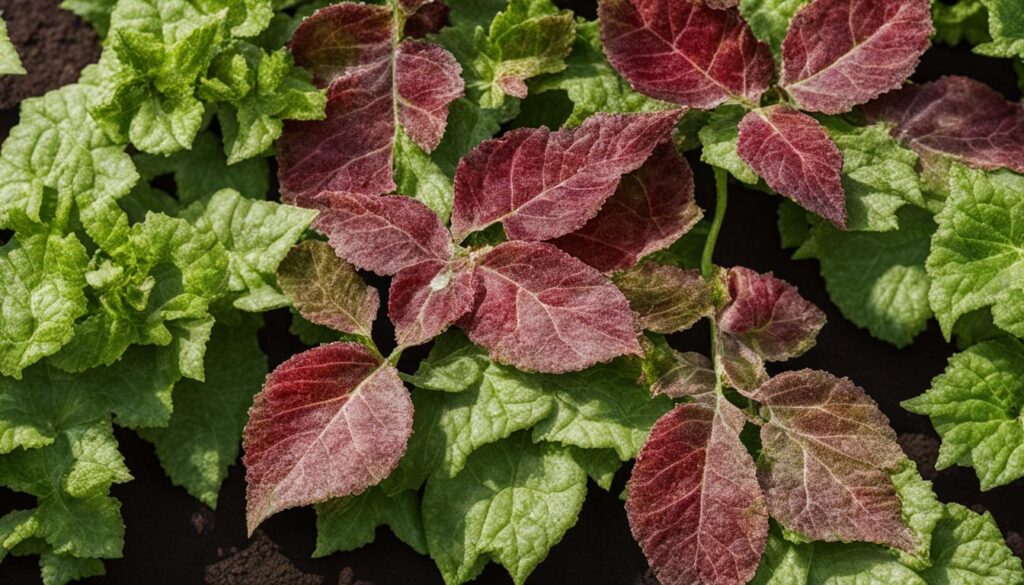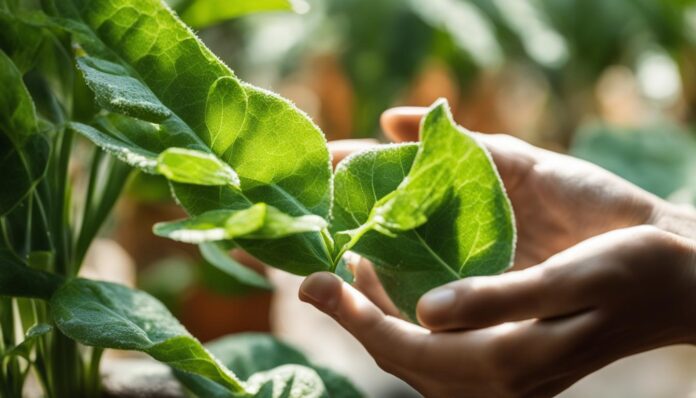Powdery mildew is a common fungal disease that affects many different types of plants. It is caused by various closely related fungal species and is favored by low soil moisture and high humidity levels. The disease usually appears later in the growing season and starts on young leaves as raised blister-like areas, eventually covering the leaves with a white to gray powdery growth.
Some of the plants that are particularly susceptible to powdery mildew include zucchini, beans, cucumbers, squash, pumpkins, tomatoes, roses, and zinnia. To prevent and control powdery mildew effectively, it is recommended to plant resistant cultivars in sunny locations, improve air circulation through pruning or staking, remove diseased foliage, use mulch or compost to cover the soil, water plants in the morning to allow for drying during the day, and avoid excess nitrogen fertilizers.
Key Takeaways:
- Plant resistant cultivars in sunny locations to prevent powdery mildew.
- Improve air circulation through pruning or staking.
- Remove diseased foliage to prevent the spread of powdery mildew.
- Use mulch or compost to cover the soil and prevent spores from spreading.
- Water plants in the morning to allow for drying during the day.
What is Powdery Mildew?
Powdery mildew is a common fungal disease that affects a wide variety of plants. It manifests as circular white spots in a powdery form, primarily appearing on leaves, stems, and fruits. The disease tends to target young foliage, resulting in leaf curling, yellowing leaves, and distorted leaves before the characteristic white symptoms become visible.
This fungal disease can affect numerous types of vegetables and ornamental plants, including nightshades (such as tomatoes, eggplants, and peppers), cucurbits (cucumbers, melons, squash, pumpkins, and zucchini), and legumes (beans and peas). Powdery mildew thrives in warm, dry climates with high humidity levels, making it particularly problematic for plants in such conditions. Infected areas on the leaves or affected plant parts can turn yellow and eventually die.
To better illustrate the appearance of powdery mildew, consider the following image:
Powdery mildew is primarily spread by wind, allowing for the dissemination of the disease spores from plant to plant. This fungal infection can take hold in areas with poor air circulation and shaded spots, further exacerbating its ability to spread.
Symptoms of Powdery Mildew Infection

Powdery mildew infection causes a general loss in the host’s growth and health, with noticeable symptoms appearing. Abnormal growth, such as leaf curling, twisting, and yellowing, may be observed before the characteristic white symptoms appear. The white symptoms appear as circular white, powdery spots on the leaves, giving the disease its name. These symptoms gradually spread and cover the leaves, leading to leaf discoloration and eventual death.
It is important to identify the symptoms of powdery mildew infection early to take necessary preventive and control measures.
Common Symptoms of Powdery Mildew
- Circular white spots: Powdery mildew initially presents as circular white spots on the leaves, stems, and fruit.
- Leaf curling: Infected leaves may exhibit curling and twisting, which can hinder plant growth and development.
- Leaf yellowing: Yellowing of leaves is a common symptom of powdery mildew infection, indicating the progression of the disease.
As the infection worsens, the circular white spots spread, covering larger areas of the leaves. The powdery growth also contributes to leaf discoloration, turning them brown or gray over time.
“Powdery mildew infection often affects the youngest leaves first, as they are more susceptible to the disease. It’s essential to regularly inspect your plants for early symptoms and take appropriate action to prevent further spread.”
Vegetables and Plants Affected by Powdery Mildew
Powdery mildew is a fungal disease that can wreak havoc on a wide range of plants, targeting different plant families with its various species. When it comes to vegetables, nightshades like tomatoes, eggplants, and peppers, as well as cucurbits such as cucumbers, melons, squash, pumpkins, and zucchini, are highly susceptible to powdery mildew. Legumes like beans and peas also fall prey to this frustrating fungal infection. However, it’s not just vegetables that are at risk. Powdery mildew can also afflict several ornamental plants, including lilacs, hibiscus, peonies, roses, succulents, dahlias, begonias, and zinnias.
Understanding the susceptibility of specific plants to powdery mildew is crucial in implementing effective preventive measures. By knowing which plants are most vulnerable, gardeners can take proactive steps to protect their beloved greenery.
Vegetables and Ornamental Plants Susceptible to Powdery Mildew
| Vegetables | Ornamental Plants |
|---|---|
| Nightshades (tomatoes, eggplants, peppers) | Lilacs |
| Cucurbits (cucumbers, melons, squash, pumpkins, zucchini) | Hibiscus |
| Legumes (beans, peas) | Peonies |
| Roses | |
| Succulents | |
| Dahlias | |
| Begonias | |
| Zinnias |
Whether you’re tending to your vegetable garden or cultivating a beautiful assortment of ornamental plants, staying vigilant against powdery mildew is essential. By recognizing the plants most at risk, you can take proactive steps to prevent and control this troublesome fungal disease, ensuring the health and vitality of your garden.
How Powdery Mildew Spreads
Powdery mildew is a fungal disease that spreads through various means, primarily through wind transmission and the presence of dormant spores in surrounding vegetation. The disease thrives in warm, dry climates with high humidity requirements, making it most prevalent in regions characterized by these conditions.
Wind plays a crucial role in the spread of powdery mildew. As the spores are released from infected plants, they can be carried long distances by wind currents. This airborne transmission allows the disease to infect nearby healthy plants, leading to the further spread of powdery mildew.
It is important to note that powdery mildew does not spread as effectively in cooler and rainy areas. The disease thrives in dry and warm climates where the relative humidity around the plant is high. However, it slows down considerably when temperatures exceed 90°F, as the high heat can inhibit the growth of powdery mildew.
Shady spots and poor air circulation also contribute to the spread of powdery mildew. The lack of direct sunlight and stagnant air provide the ideal conditions for the disease to thrive, allowing it to spread more easily among susceptible plants.
By understanding how powdery mildew spreads, gardeners and growers can take appropriate preventive measures to minimize its impact. Adequate spacing between plants to ensure good air circulation, removing infected plant material promptly, and maintaining proper watering practices can help reduce the spread of powdery mildew.
| Powdery Mildew Spread: | Transmitted by Wind |
|---|---|
| Primary Mode of Transmission | Wind currents carry spores from infected plants to healthy plants |
| Additional Means | Dormant spores in surrounding vegetation |
| Preferred Climate | Dry and warm climates with high humidity requirements |
| Effects of Temperature | The disease slows down when temperatures exceed 90°F |
Preventing and Treating Powdery Mildew
Preventing and treating powdery mildew is crucial for maintaining the health of your plants. There are several effective strategies that you can implement to prevent powdery mildew from taking hold. Planting resistant cultivars in sunny locations can help reduce the risk of infection, as sunlight inhibits the growth of the fungus. Improving air circulation around your plants by pruning or staking can also create an environment less conducive to fungal growth.
Another important preventive measure is removing any diseased foliage promptly. Powdery mildew thrives in areas with high humidity, so it’s essential to reduce moisture levels around your plants. Applying a thick layer of mulch or organic compost can help retain soil moisture and prevent splashing of fungal spores onto the leaves. Additionally, watering your plants in the morning allows the leaves to dry out during the day, minimizing the chance of infection.
If powdery mildew does appear, there are several home remedies and natural fungicides that you can use to treat the infection. Milk sprays, baking soda solutions, neem oil, and sulfur or copper-based fungicides have been found to be effective in combating powdery mildew. For those seeking organic control options, potassium bicarbonate and broad-spectrum fungicides can be utilized to manage the disease.
To effectively manage powdery mildew, it’s important to regularly monitor your plants for any signs of infection and intervene at the earliest opportunity. By implementing these preventive and treatment strategies, you can effectively prevent powdery mildew and maintain the overall health of your plants in an eco-friendly and sustainable manner.
FAQ
What is powdery mildew?
Powdery mildew is a common fungal disease that affects a wide variety of plants. It appears as white, powdery spots in a circular pattern on the leaves, stems, and fruit. Young foliage is most vulnerable to the disease, and infected leaves may exhibit curling, twisting, and yellowing before the white symptoms become visible. The disease spreads and covers the leaves or affected areas, causing them to turn yellow and die.
What are the symptoms of powdery mildew infection?
Symptoms of powdery mildew infection include circular white spots on the leaves, leaf curling, twisting, and yellowing. The white symptoms gradually spread and cover the leaves, leading to leaf discoloration and eventual death. It’s important to identify the symptoms early to take necessary preventive and control measures.
What vegetables and plants are affected by powdery mildew?
Powdery mildew can affect many types of plants, including vegetables such as nightshades (tomatoes, eggplants, peppers), cucurbits (cucumbers, melons, squash, pumpkins, zucchini), and legumes (beans, peas). Additionally, ornamental plants such as lilacs, hibiscus, peonies, roses, succulents, dahlias, begonias, and zinnias can also suffer from powdery mildew.
How does powdery mildew spread?
Powdery mildew spores are primarily transmitted by wind. The disease thrives in warm, dry climates but requires high relative humidity around the plant for successful spread. It can also originate from dormant spores in surrounding dead vegetation or weeds. Powdery mildew spreads through the air, infecting nearby plants through wind dissemination of spores. Shady spots and poor air circulation can contribute to the spread of the disease.
How can I prevent and treat powdery mildew?
Preventing and treating powdery mildew involves several strategies. It is recommended to plant resistant cultivars in sunny locations, improve air circulation through pruning or staking, and remove diseased foliage. Applying a thick layer of mulch or organic compost and watering plants in the morning can further prevent the disease’s spread. Several home remedies can be effective in treating powdery mildew, including milk sprays, baking soda solutions, neem oil, and sulfur or copper-based fungicides. Organic options such as potassium bicarbonate and broad-spectrum fungicides can also be used. Regular monitoring and early intervention are key to effectively managing powdery mildew and maintaining overall plant health.

